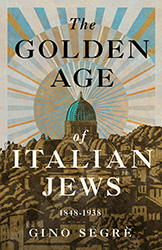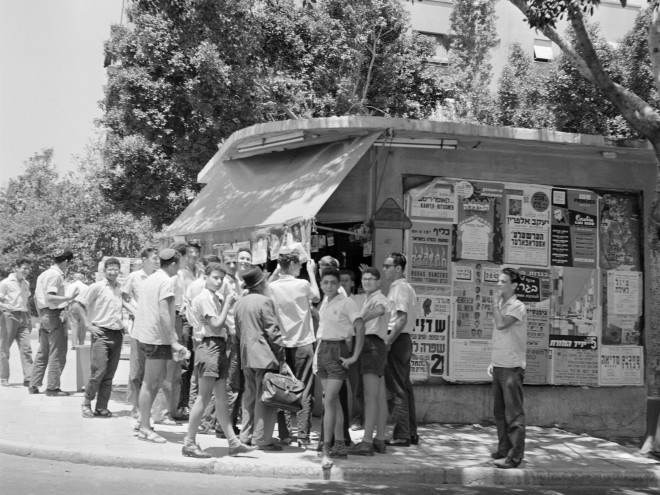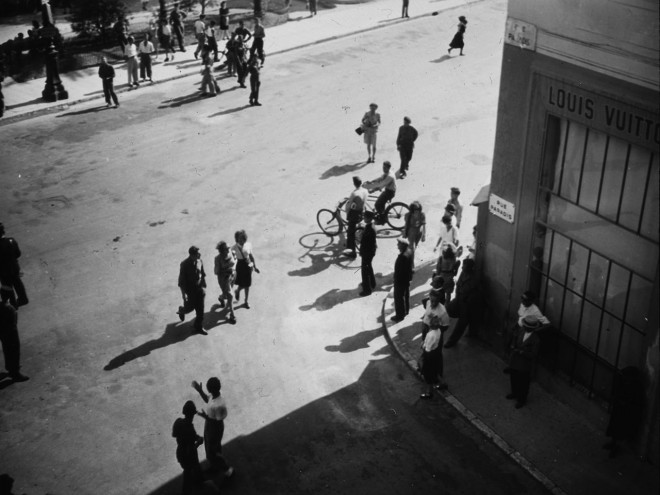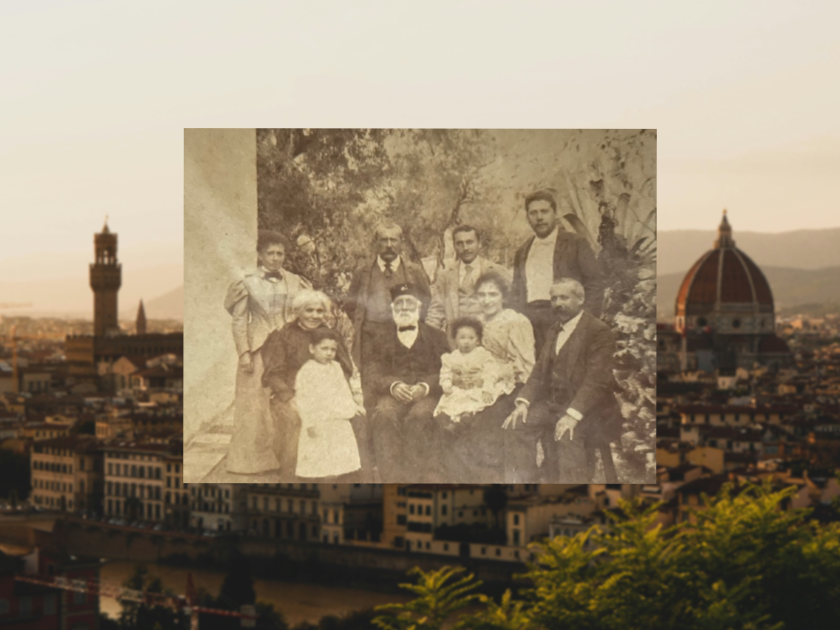
Segrè family photo in 1893, courtesy of the author
Background photo of Florence by Eugeniya Belova on Unsplash
My interest in writing my new book, The Golden Age of Italian Jews: From 1848 to 1938, was spurred by the chance to delve into my own family history and relate it to the arc of Italian Jews during this period. My research began by examining where Jews stood in the mid-1800s, a time when my father’s paternal grandfather, Angelo Segrè, owned a small store in Bozzolo, a little town near Mantua. He and his wife, Egle, had four children who lived beyond infancy. Their middle son, Giuseppe, my grandfather, went into commerce and became the head of a paper mill near Rome. Their other two sons, Claudio and Gino, attended university and had notable careers, one as a geologist and the other as a law professor. Both became members of the Accademia dei Lincei, Italy’s equivalent of the British Royal Society. Their sister, Bice, married a chemistry professor at a university.
My maternal great-grandfather, Marco Treves, was born in a ghetto in Vercelli, a city in northwestern Italy. He left Vercelli for Florence; in this more liberal city he pursued studies at the Academy of Fine Arts of Florence. By the mid 1800s he was a successful architect in his adopted city. Despite being a Jew, he had no difficulty in submitting a proposal in 1860 for an envisioned new façade to Santa Maria del Fiore, the city’s central church commonly referred to simply as the Duomo. His design was widely admired, but ultimately did not win the competition. However, he did win the competition for the design of the city’s new synagogue, the Great Synagogue of Florence, a widely admired edifice. It was his grandest project.
Marco Treves and his wife, Elisa, had four daughters and one son, all successful by the standards of their time. Their youngest daughter, Amelia, born in 1864, was my grandmother. She and Giuseppe Segrè had three sons. Two of them, both academics, took refuge with their families in the United States in 1939 while the third went into hiding with his own family when the Germans took control of Rome in 1943. The sons entreated their parents to emigrate but they felt too old for such a change. They thought they would be safe. Tragically, Amelia was seized in the infamous October 16th 1943 Nazi roundup of Roman Jews. She died in Auschwitz.
My family history in Italy reflects both the highs and lows of the Jewish experience here during this period. In 1848, Italy was not yet the nation whose borders we know today; it was a collection of territories ruled by a local potentate, or a foreign monarch, and had a vast swath of land at its center governed by the Pope. Rome’s population was two hundred thousand, the same number it had been three centuries earlier. In the meantime, London had become a metropolis with over three million inhabitants, Paris had grown to almost two million, and New York City housed almost one million. The great economic surge associated with the Industrial Revolution had bypassed Italy. Without natural resources of coal or iron, Italy was still an agrarian country, and a relatively poor one at that. Overcultivation of the soil had all too often left the land barren, poverty was rampant, literacy was at or below 30%, and life expectancy was far lower than in northern European countries.
Where did Italy’s Jews stand in this picture? Never more than forty thousand, they were a miniscule part of the country’s overall population, about one in a thousand. Their origins were varied. The sixteenth century had seen the arrival of Ashkenazim fleeing persecution in Northern Europe and Sephardim escaping from Spain and Portugal. There was also a large movement of Jews from southern Italy to Rome and other northern areas because Sicily and nearby regions had come under Spanish rule that was hostile to Jews. Last, but not least, there was a small Jewish population in Italy that traced their ancestry back to Caesar’s Rome. By the nineteenth century, after hundreds of years of assimilation and intermarriage, these three groups were simply Italian Jews, their origins insignificant. During the nineteenth century the laws that had confined Jewish populations in ghettos were also disappearing. The last remaining ghetto was in Rome, abolished by the nascent Kingdom of Italy’s conquest of the city in 1870.
Italy’s unification, which concluded with that conquest, had been spearheaded by the Kingdom of Sardinia, a region in the northwest. The Kingdom of Sardinia granted Jews in their domain full civil rights in 1848, giving them access to public careers closed to them until then. And so when Italy was unified later in the 1800s, this example was followed. Integration into Italian society was made easier because Italian Jews looked like other Italians, dressed like them and, not having a different language of their own such as Yiddish, spoke like them. In many cases, they had also fought side by side with other patriots in the battle for Italian unification. Italian Jews also benefited from the Pope’s enmity toward the new Kingdom of Italy. He had excommunicated the country’s King, its Prime Minister, and, after 1870, retreated to the Vatican, refusing to recognize the Kingdom’s legitimacy. Though largely ignored on this issue, he even encouraged Italian Catholics not to participate in governing the country. Since public opinion was mostly in favor of the unification, this turned many people away from the Pope in a new way.
Italian Jews also had certain advantages in seeking assimilation and advancement. Rather than farming, their main employment had been in commerce, particularly in moneylending. The skills used in this industry were needed in a modernizing society. Furthermore, the connections they had with other Jewish communities scattered throughout the Mediterranean gave them a further advantage.
By World War I, Italy had seen Jewish generals, admirals, and a Minister of War. Jews had held many cabinet positions in government, including Foreign Secretary, Minister of the Treasury, and even served as Prime Minister. From 1907 to 1914 the mayor of Rome was a Jew. In some ways, the most surprising shift was in the number of Jews who became university professors, perhaps a reflection of how Jews at the time viewed education as a means of moving upwards in society. Since Italian universities, with very few exceptions, were state institutions, there were no quotas for admission unlike what was the case in many other countries during this time, including the United States. By the early twentieth century Jews constituted almost 10% of university’s faculties, remarkable since they were only a .1% of the population.
The integration of Italian Jews into society came to a relative standstill with Mussolini’s rise to power in 1922. This happened slowly at first and then dramatically, as Mussolini grew ever closer to Hitler. In 1938, Italy passed racial laws that deprived Jews of all the rights they had enjoyed for almost a century.
In the years that followed Italian Jews suffered, but the worst did not come until 1943. In September of that year Italy surrendered to the Allies and Mussolini was deposed. However, German forces occupied Italy and brought the Final Solution to the country’s Jews.
And that was when my grandmother Amelia was one of many who was rounded up and deported to Auschwitz.
In one of the many ironies of this historical sweeping tale, Amelia’s youngest son, my uncle Emilio, was a top physicist working in the secret city of Los Alamos during World War II. Later on he would win a Physics Nobel Prize. But in 1943 he was helping build an atomic bomb. He was informed by J. Robert Oppenheimer, head of the Manhattan Project, that his mother had been seized in the Nazi raid in Rome and likely sent to a concentration camp. After disbelief and grief, Emilio felt he needed to work harder than ever with his colleagues to bring an end to this devastating war and extermination campaign.
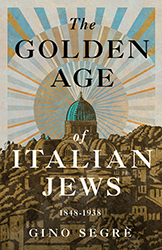
The Golden Age of Italian Jews: 1848 – 1938 by Gino Segrè
Gino Segrè has authored five books on the history of science: A Matter of Degrees (2002), Faust in Copenhagen (2007), Ordinary Geniuses (2011), The Pope of Physics (2016) with Bettina Hoerlin, and Unearthing Fermi’s Geophysics (2021) with John Stack. The Pope of Physics was a New York Times Book Review Editor’s Choice and named a Best Book of the Year by Bloomberg; Faust in Copenhagen was a finalist for the LA Times Book prize. Segrè was born in Florence, Italy and raised there and in New York City. He is a former chair and professor emeritus of physics and astronomy at the University of Pennsylvania and has received awards from the National Science Foundation, the U.S. Department of Energy, the Alfred P. Sloan Foundation, and the John Simon Guggenheim Memorial Foundation. He lives in Philadelphia with his wife Bettina Hoerlin.
